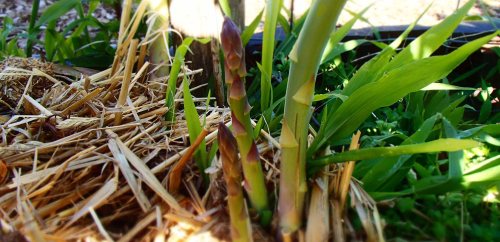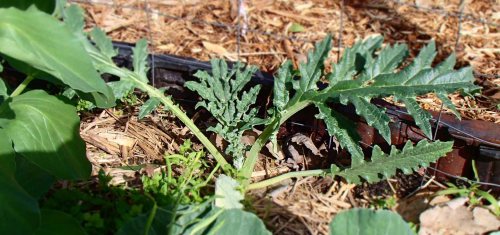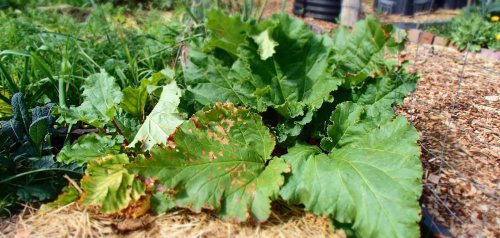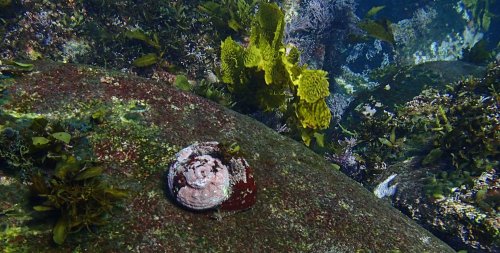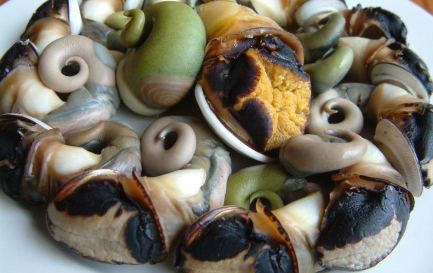Two years ago, I forked out some good money on some good 2 year crowns of asparagus (Asparagus officinalis). With their first year going by unharvested while they built up strength, it is now finally payday, as beautiful crisp spears push up through their mulch of stable straw and kelp (Ecklonia radiata) . Two weeks ago I ordered some bulbs of ginger (Zingiber officinale), Jerusalem artichokes (Helianthus tuberosus) and yacon (or ‘Peruvian ground apple’, Smallanthus sonchifolius). Today it is planting day. A few months ago, I put in a globe artichoke (Cynara cardunculus var. scolymus), just a single plant in among the winter broad beans to see how it would go – and the answer is well enough I think to put in a few more. That gets planted as seed today as well.

Jerusalem artichokes (Helianthus tuberosus) – neither artichokes nor from Jerusalem, but above ground like girasol (Spanish for sunflower), whence comes part of the name.when mispronounced
My allotment is going perennial. During summer at least, illogical as being seasonally perennial may sound. When many of these plants die off or are cut back in winter I will probably crop some broad beans (Vicia faba), Tuscan kale (Brassica oleracea var. acephala ‘Cavolo nero’) and maybe another brassica or two. Around the edges, I have been encouraging some self-sown comfrey (Symphytum × uplandicum) and managing the mint (Mentha sp.) down to useful (kitchen herb and pest-deterring companion) rather than weed proportions. The rhubarb (Rheum rhabarbarum) is going well, thriving on this wet winter, having previously struggled in our sandy coastal soil in drier times.
A big motivating factor for the change to perennials is accepting that in the peak summer-autumn growing months from December through to April I tend to lose control of the garden. Failures to water or weed can lead, depending on the year and what I have planted, to jungles or deserts of less than ideal productivity. And this is the time of year when I am most likely to be away or be busier with other things (like the sea at its best). But with the deeper rooted perennials having less regular watering needs, and growing well over a metre high and able to push and shove with the best of the weeds, the strategy is to partly let it go wild. And I can hopefully do this knowing that a solid half day’s work in autumn will be a harvest, a return to order and a preparation for the winter cropping all in one.
This partial wildness is where it gets conceptually particularly interesting for me. I have written before how the transition from foraging to farming in most of our cultural histories was not an agricultural revolution but a gradual coevolution, with people initially making some quite simple steps to influence the abundance and distribution (or in a word, ‘ecology’) of food plants and animals. It was still probably best described as foraging when the wild progenitor of yacon in South America had its rhizomes replanted after it was dug up for its roots – northern Australian Aboriginal people who did the same with some wild yams have never been called farmers for it. Similarly for ginger in South Asia and asparagus in Europe and western Asia. So when I do this next autumn in my allotment? The difference is mainly just in how we think about it rather than what we are actually doing.
Permaculturalists speak about zonation in their ‘gardens’, from carefully tended herbs and salad greens by the back door, through vegetable gardens and food forests to the woodlot in the farthest reaches that could actually be a barely touched native forest. Again, it is a continuum, and essentially the same one as between farming and foraging. For me, my zonation is very disjointed. From my herbs out the front of the apartment building, to the community garden allotment over the hill, the office salad garden across town, the scattered efforts on the bush block 3 hours away, and a whole lot of wild food places on land and sea in between. In the conceptualisation of all of this, my allotment has just moved; it has become wilder, closer to foraging, and I have to say that I like it more this way.
